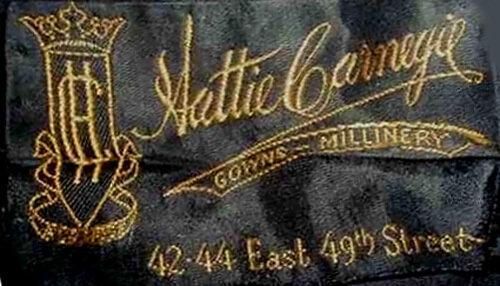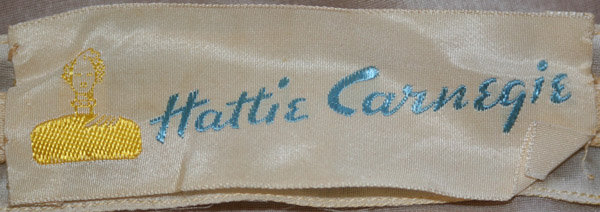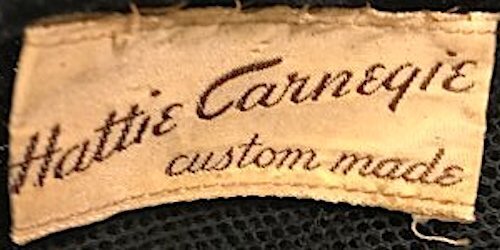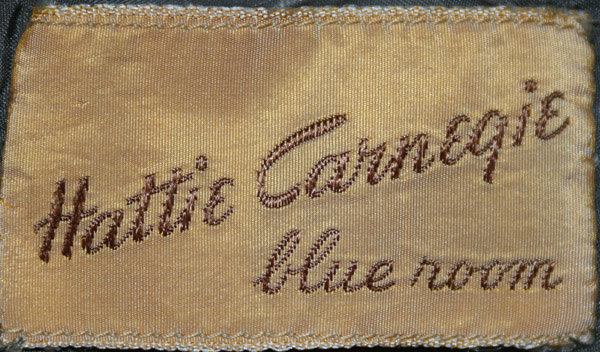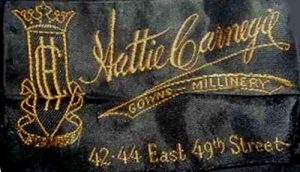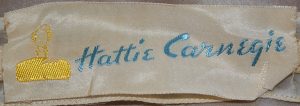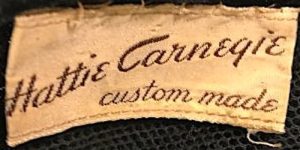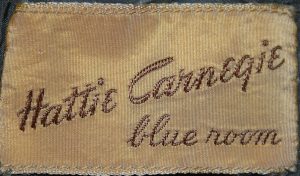Hattie Carnegie (1889-1956) was born as Henrietta Kanengeiser, in Vienna, Austria in 1889. In 1900, she immigrated to the United States, and settled with her family in New York City. By the time she was a young teenager, Hattie was already working. She worked at various millinery establishments, and at Macy’s. But in 1909 she, along with friend Rose Roth, opened her own business, a tiny hat shop. It was called “Carnegie – Ladies’ Hatter.” They also sold dresses, which were made by Rose, as Hattie could not sew. Hattie did the hats. The shop was a success, and four years later they moved to a larger place and were able to incorporate as a business.
As the business grew, Hattie and Rose were able to hire workers who made the designs that Hattie developed. At this time, fashion came from Paris, and so Hattie studied the Parisian styles, choosing only the best, and adapting them for her customers. And while she could neither sketch nor sew, Hattie was very good at communicating to her workers exactly what she wanted them to do. In 1919, Hattie bought Rose Roth’s share of the business, and Hattie Carnegie, Inc. was born. This was also the year of her first buying trip to Paris. She bought French Couture dresses to take back to New York to sell, and to also use to make adaptations.
Until 1928, all the dresses at Hattie Carnegie were made to order, but in that year she started her first ready-to-wear line with Norman Norell as the designer. By this time, Hattie’s business had grown to be the size of a small department store. In 1929, before the Stock Market Crash, she did $3,500,000 worth of business! At first the Crash seemed to have little effect on the business at Hattie Carnegie, but then many of her formerly wealthy patrons found they could not pay their bills. Carnegie decided to start a new division which was much lower in cost per dress. This new line was called Spectator Sports, and dresses in that line sold for about $40 each (Still high for 1934, but much lower than her custom work!)
So in spite of the depression, Carnegie’s business thrived. She opened even more departments in her store. It was said that a lady could be dressed from “Hat to hem” at Hattie Carnegie (the one item she did not have being shoes!) By the 1940s, Carnegie’s store was actually a department store. There was a handbag shop, where a customer could order a bag to match an outfit or hat, the fur salon which was next to the Custom Salon, a millinery shop and a ready-to-wear hat shop, her jewelry department, an antique shop that sold furniture, china and glass, a cosmetic and perfumes department, the Jeune Fille shop which sold Spectator Sports and ready-to-wear from other design houses.
She also began selling her ready-to-wear dresses, hats and accessories in stores around the country in the late 1930s. Her clothes were particularly popular in California, and many Hollywood stars were known to wear Carnegie’s clothes. This helped spread her reputation and helped establish her as a taste-maker across the country. She also began to market her cosmetics and perfumes in stores across America. She was well-known enough to be asked to endorse other products.
By 1940, Carnegie’s operation was so large that it employed over 1000 workers. Most of them worked in the manufacturing of her ready-to-wear lines, but her custom shop continued to be the foundation of her business and reputation. Carnegie became known as a woman of taste, and she was so renowned that she was often featured in her own ads.
During the War, Carnegie continued to be a leader in the American fashion scene. But because access to French fashion and fabrics had been curtailed, she had a very prominent place in the fashion publications of the era. And during the War, she began to rely more on American fabric designers and manufacturers, and she continued to use them even after the War ended.
During the 1950s, Carnegie continued to make the types of clothes that women across the country had come to expect from her – chic but conventional dresses and suits. She especially liked the little black dress, and was known for using a particular shade of blue – “Carnegie Blue.”
Hattie Carnegie died in 1956. Her business remained open, first under the direction of her husband, John Zanft, and then by a former employee, Larry Joseph. Unfortunately for the business, much of the desirability of the label lie in the woman herself, and after her death, the label lost a lot of its luster. The Custom Salon was closed in 1965, but the company continued to produce jewelry, hats and accessories. The business closed for good in 1976.
One of Hattie Carnegie’s most important legacies to American fashion was that her workrooms were a sort of fashion designer incubator. Starting with Norman Norell in 1928, there is a long and impressive list of noted designers who passed through the Carnegie organization. These include Claire McCardell, Ann Lowe, Jean Louis, Gus Tassell, James Galanos, Travis Banton, Pauline de Rothschild and Pauline Trigere. Unfortunately, these designers were never given credit on the label for their work. Many collectors look for Carnegie garments that show characteristics of the work of these famous designers.
Hattie Carnegie is very often associated with elegance and high fashion, and even her ready-to-wear and more casual clothing always had a touch of the elegant. Carnegie’s fashion philosophy is often summed up as the woman should wear the clothes, not the clothes wear the woman.
Written by fuzzylizzie
